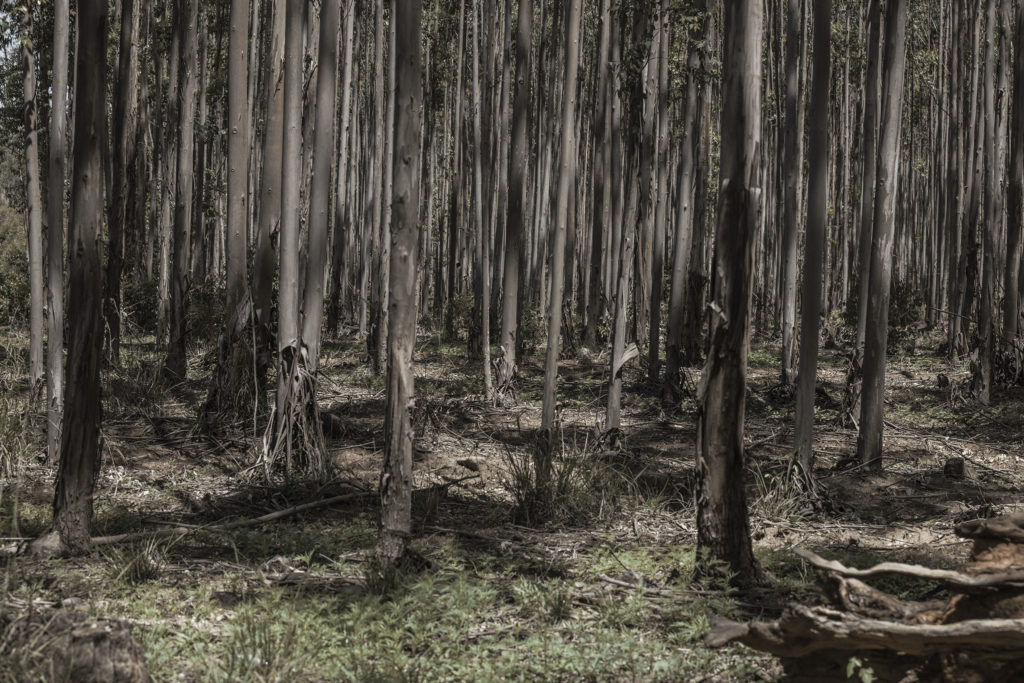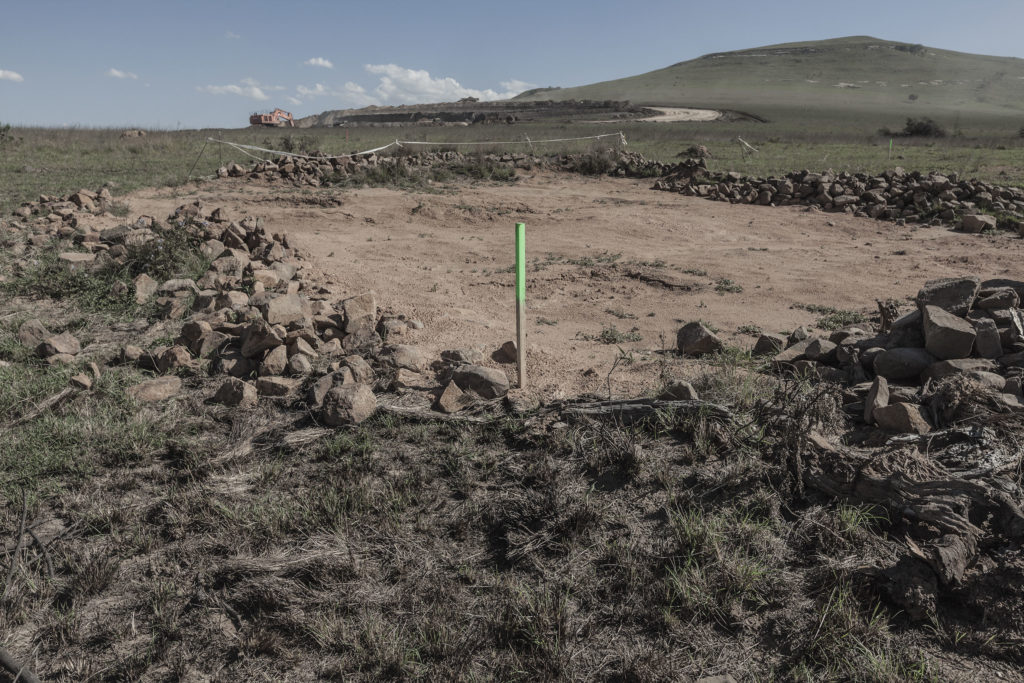Stolen land: ‘Ranch or homestead?’ A farm house in Commondale. (Santu Mofokeng)
Are these mere solemn relics of disrupted narratives or are these images expressive of the general human predicament?
Ancestors: Fearing the Shadows was first exhibited as part of the German Pavilion at the 55th Venice Biennale in 2013. That year also marked the 100th anniversary of the passing of the Native Land Act, a cornerstone of the apartheid laws. What follows is an excerpt of that show. The emphasis, however, is different.
The Native Land Act of 1913 set aside territories in South Africa, known as “native reserves”, within which tribal chiefs ruled the remnants of their historic domains. In many of these places, chiefs still rule to this day. Chieftaincies are relics of the past and, therefore, considered “backward” or what Jean-Paul Sartre termed “idiocy” in this statement: “the idiocy of rural life”.
 Ephemeral shadows: A suspected graveyard in Piet Retief (Santu Mofokeng)
Ephemeral shadows: A suspected graveyard in Piet Retief (Santu Mofokeng)
Chiefs are careful to attend to their glories, despite having been left with areas of land that suffer from erratic water supplies or no electricity in the homes of many of their subjects — not to mention the loss of access to the lands of their ancestors, where the rituals necessary for maintaining their power should be performed still, lest their authority disappear. Worse yet, the Native Land Act left these people with little to no access to ancestral burial grounds, limiting their ability to bury their dead and practice traditional rituals.
Thriving farming communities vanished after this law was passed, and the land was given away wholesale to people who were not native. This handing out of land made way for the plantations that feed the insatiable paper and pulp mills, and mining shafts that fuel a rapacious capitalist system based on an economy of extraction.
But who is to blame?
For a start, I give the journalist credit for simply standing up to me. Allow me to confess to one thing though, and that is, at that time I was not paying attention to what she was saying, and words like “venomous,” “vehement” or “insouciant” could easily mean she was insistent. After too many years of living quarantined under apartheid rule, I should have known better social graces than to raise the subject. Disproportion was reality under apartheid.
 Palimpsest: Commondale graveyard has been turned into a mielie farm. (Santu Mofokeng)
Palimpsest: Commondale graveyard has been turned into a mielie farm. (Santu Mofokeng)
Exactly whose fault is it that the Native Land Act was passed 100 years ago in South Africa, ushering in apartheid policy, helping articulate that very policy, inadvertently producing non-persons. What is germane today is, once the die is cast we see where the dominoes fall. Blade Runner director Ridley Scott puts my sentiment nicely. To paraphrase, he said of his working methods: “Nothing is in straight lines … I don’t think in straight lines I still put things on a blanket … flip it … see which way [it] lands. That’s when you find out and suddenly you start to formulate the logic.”
Most people thought the floodgates of economic growth would open as soon as South Africa’s policies of apartheid rule fell. Today, it is no longer business as usual for companies wishing to exploit black labour as they used to. Now, since the democratic South African state was established in 1994, civil society shows its political muscle.
Profit should not be used as a prime metric in the way we do business, especially because we are discovering that the world is finite and that profit is not limitless. Rather, we are living the effects of mindless profit making. — Extract of text by Santu Mofokeng displayed at the 8th Berlin Biennale, May 2014
“”After too many years of living quarantined under apartheid rule, I should have known better social graces than to raise the subject. Disproportion was reality under apartheid.
Ancestors: Fearing the Shadows
My sister calls me outside to come and have a look at something. There is an edge and insistence in her voice.
It’s early afternoon and it is typically windy, sunny and dry at this time. I am renting a two-bedroom house in Diepkloof, Soweto in one of the so-called new houses that are styled according to affordability and taste of the owner. These houses are a cute variation of typical and monotonous centrally planned 51/6 standardised 40m2 architecture dominating Soweto, commonly referred as matchbox houses. These “new” houses are built on an in-fill site in zone 3; they are not far from the charming, disease-laden “white” mountains — Shaft 17 slime dams — where we used to frolic as kids growing up in the older adjacent township of Orlando East, with makeshift sleds — upturned motor-car scrap metal of front or back car-hoods, bonnets or boots, as the case may be. The Soweto Highway bisects this township into old and new zone 3, as taxis, buses, lorries, delivery trucks and sedans blast past in the direction of the city. The place is always enveloped in a sheen of yellow dust in the dry and windy months of autumn and winter.
“What is it?”
“Don’t you see?”
“I don’t see anything.”
“You don’t see the snake. There, that is the tail. The head is on the ground.”
All I see is air turbulence, a tiny twister, a disturbance of air caused by heated earth, macadam and tar mixing in with the cold wind or breeze, creating a convection current, (vortex) sucking in rubble, dust and dirt along the way from the streets, whirling it around in its progress through the township. This is, of course, limned against predominantly red rooftops made of tiles and corrugated iron, some rusting and cracking in the blistering sun and painted black or green of houses, garages, shops, filling stations and wooden or metallic of electricity and telephone poles and ubiquitous antennas and satellite dishes. In the far distance you can see craggy slime hillocks reminding one they are in the golden city. At this time, Diepkloof’s landscape is a bleak backwash of the gold rush. It is a far cry from the promises associated with gold and wealth.
 Buried secrets: An exhumation in progress at the Driefontein Graves. (Santu Mofokeng)
Buried secrets: An exhumation in progress at the Driefontein Graves. (Santu Mofokeng)
In the day I assume the sober, reasonable attitude accepted as convention. I espouse the trappings of being regarded as erudite. At home I try to blend in the gossamer aspect of dreamscapes, with people who read omens and signs in anything and everything — people who predict and claim to see conspiracies before they arise. It seems exciting for one to be able to, or forced to, travel in time and inhabit disparate universes in a day. To the comfortable among us these days my kind of existence is a drudge to be tolerated en passant for amusement only.
Do you wish to be ancestor? It’s easy, you see. You don’t need any special qualities or qualifications. You simply have to show and express your willingness to die and I will ancestralise you. You will join in the illustrious gallery or pantheon of the likes of Mohapeloa, Caluza, Sekoto, Shaka, Moshesh, Gaika, Maqoma and Nongqawuse and so on and so forth. You will be jostling for position alongside the likes of Piet Retief, De La Rey and Siener (read: prophet) Marais and his visions of doomsday when democracy was knocking at the door in South Africa.
Do you think Elvis Presley, Shakespeare, Picasso, Michelangelo, Churchill et cetera or, closer to home: Leipoldt, Alan Paton, Pierneef, and Verwoerd are ancestors? They are all dead, aren’t they? Why aren’t they referred to as ancestors?
 A Driefontein Mine expansion potentially threatening a gravesite (Santu Mofokeng)
A Driefontein Mine expansion potentially threatening a gravesite (Santu Mofokeng)
Except, they are not dead, you see. They are referred according their achievements in life, either as poets, philosophers, artists, statesmen or activists, martyrs, et cetera. They are held as epitomes of culture, refinement and progress. Technically they are dead, of course. But in popular memory they are alive and content to live in our imagination.
Ancestors perceived to be martyrs animate only those who wish to foment discontent and violence. Generally, ancestors need grounding, a landscape or territory, to be sure. In death they agitate for space among the living. We are fortunate to be living quarrels not of our own making. We conjured up through remembrances, national holidays and anniversaries, when even the dead have a vote.
Who needs ancestors? This is a question of belief and of religion. One is compelled to suppose, but is it? Karl Marx’s remark: “opium for the masses” resonates. Religious extrusions are everywhere on the landscape, both virtual and real. Ancestors lived here once and their signature masks and accoutrements are sometimes preserved and coveted to attract tourism. Marx notwithstanding, many people will tell you that you are nothing without a past or, that you are not “together” without belonging. Another issue is the matter of national and quasi-religious holidays and monuments and memorials and anniversaries, so coveted by governments and politicians to shore up waning popularity and to mesmerise crowds.
I write elsewhere that nothing forces a backward glance like a threat. The Chinese say that our body is the memory of our ancestors. This is an ominous proposition since apartheid is an impossible ancestor, inappropriate and unsuitable. Whenever we come under threat we remember who we are and where we come from and we respond accordingly. The word “remember” needs elaboration. Re/member is a process by which we restore to the body forgotten memories. The body in this case is the landscape — on whose skin and belly histories and myths are projected — which is central to forging national identity.
When I see air turbulence my sister sees a snake. As a photographer I hunt for things ephemeral, such as shadows, to create images. Interpretation I leave to the beholder.
Born in 1956, photographer, writer and thinker Santu Mofokeng passed away on January 26 at the age of 63. These images and the essay above appear in Graves, 2012, published by MAKER.